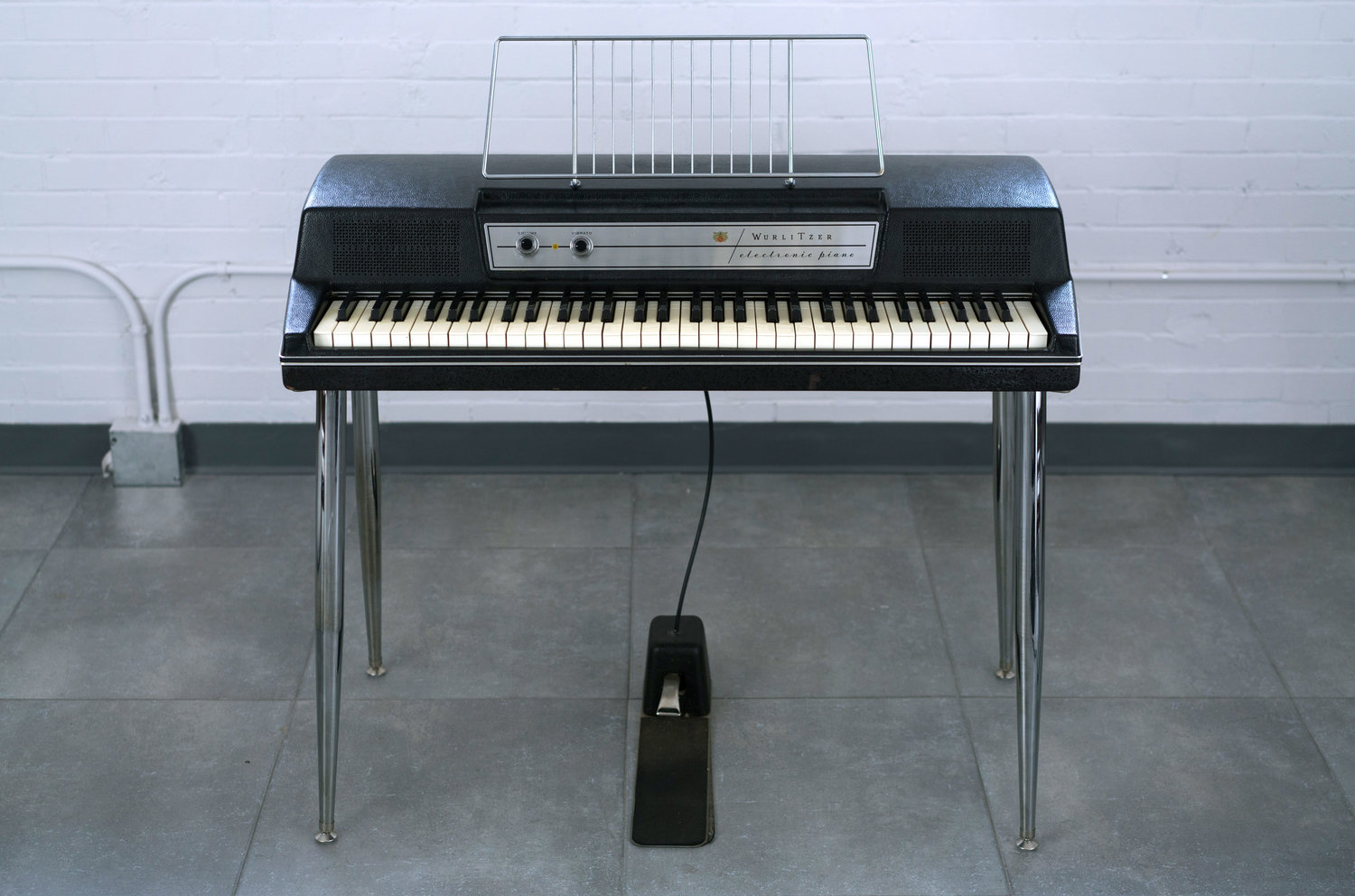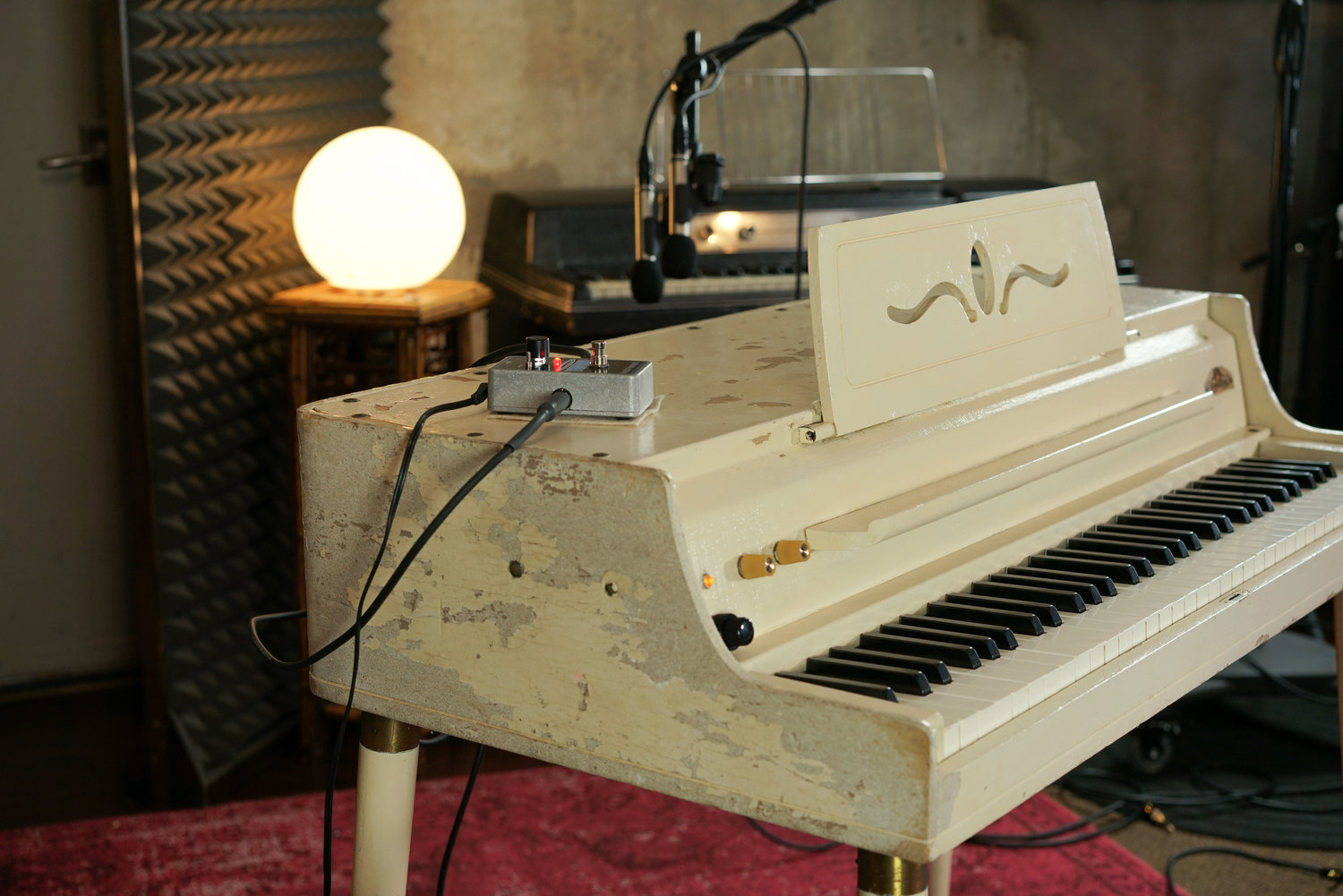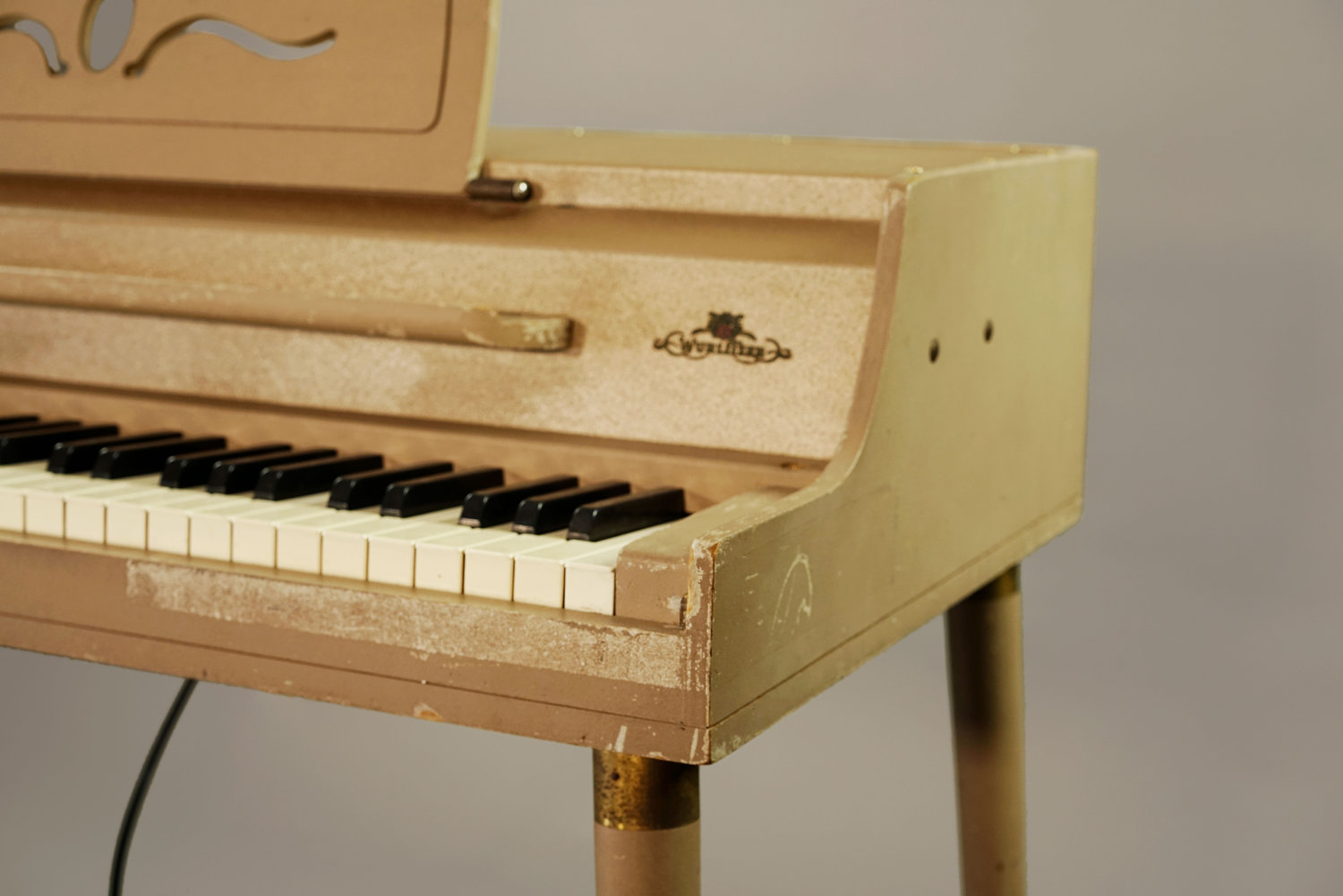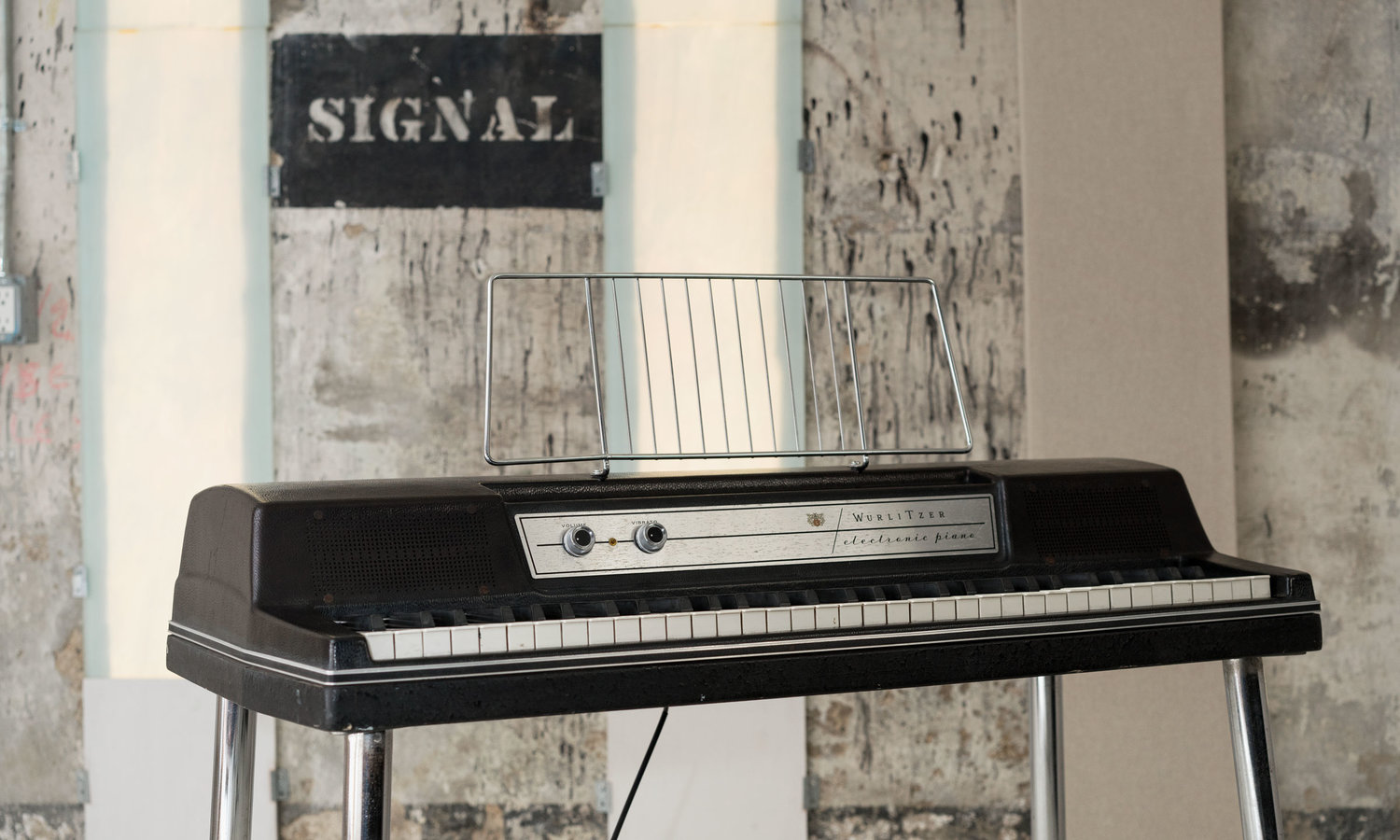What is the Difference Between a Wurlitzer 140 and a Wurlitzer 200a or 200?
A vintage Wurlitzer 206, and a version of the same keyboard on legs.
Wurlitzer in the 140 series are transitional models: more reliable than Wurlitzer’s earlier electronic pianos, but not as portable as later models. On the other hand, the 200-series is the iconic final iteration of Wurlitzer keyboards: smaller, lighter, more chrome. If there’s a Wurlitzer 140 (or any of its many variants, from the 140b to the 145) that has caught your eye, you may be wondering if buying it is a good idea. How does it stack up against the 200a? Does it require more work? What are the practical differences between them? This guide is here to help.
Although 200 models are much more common, 140-series Wurlitzers are excellent keyboards that are often overlooked. Although they have a more vintage midcentury appearance, 140-series Wurlitzers are more than capable of performing just as well as their 200-series counterparts. This guide will help you determine if a 140-series Wurlitzer is right for you, or if you’d benefit from the relative newness of a 200-series.
Just tell me: which one is better? If you’d like an electronic piano that has statement-making vintage styling and a warm and uniquely-voiced amplifier, choose the 140-series Wurlitzer. If you require the utmost portability and prefer more modern electronics, choose the 200-series Wurlitzer.
Remember: condition is the most important factor. Note that both models of keyboard are only as good as the condition that they are in. A Wurlitzer that is in total disrepair will require a lot of time and money to fix, regardless of what model it is.
Differences between 140- and 200-series Wurlitzers
A Wurlitzer 140a with cosmetics in original condition.
Cabinet
The most obvious difference is the cabinet. 140-series Wurlitzers are housed in a wooden cabinet with a metal lid, while the 200-series is mostly enclosed in plastic. This makes the Wurlitzer 140 heavier: 81 lbs, according to the service manual. This additional weight, along with the larger dimensions of the cabinet, makes the 140 more difficult to handle alone. However, if you have the help of another person, it is easy to move.
Because the 140-series has a more enclosed cabinet, the initial service that your Wurlitzer requires will be a little more laborious. In a 200-series model, you can remove the entire action assembly as a unit, but this isn’t possible in a 140. This type of disassembly is really only necessary if the keyboard has been in a state of neglect for a long time, and requires a thorough deep cleaning and restoration. The keyboards that we sell have already been cleaned and restored both electronically and mechanically, so we’ve gone through the trouble for you. However, if you are thinking about purchasing an unrestored keyboard, this is something that you should keep in mind.
The legs on a 140-series unscrew and can be mounted inside the lid, a feature that the 200 lacks. This is convenient because it provides built-in storage for the legs, which are easy to lose and also easy to damage, if you for instance just throw them in the back of your car. Once the lid is reattached to the 140, the entire piano becomes a convenient box for transport or storage. The lid also protects the keys when the piano is not in use, which is why the keys on so many 140-series Wurlitzers are in such excellent condition.
Shielding
On a 140-series Wurlitzer, the metal lid functions as a shield. Because the lid of a 200/200a Wurlitzer is plastic, it requires a metal hum shield underneath.
All Wurlitzers require shielding to prevent the pickup from introducing hum into the amplifier. In the 140, the metal lid acts as a shield. In order for the lid to shield effectively, it must connect to the amplifier’s chassis ground. This is accomplished via a large braided cable that is stapled to the lip of the 140. When the lid is screwed down, the cable is wedged between the lid and the cabinet. The interior of the cabinet is additionally painted with conductive paint, so that the lid, the amp chassis, and the cable are all connected.
The lid of a 200-series Wurlitzer, on the other hand, is plastic, which doesn’t have any particular shielding qualities. Instead, a 200a comes with two interior shields: a hum shield, which mounts over the dampers, and a reed bar shield, which is a comb-shaped strip of metal that mounts over the pickup. Most 200 models do not have a reed bar shield. If you purchase a 200, you’ll need to purchase one in order to achieve the least noise floor possible. (We always include a reed bar shield in the 200 models that we sell.)
Mechanical action
Wurlitzer updated the mechanical action for the 140-series, so all of the mechanical parts are similar or identical to those in the 200-series. This makes the 140-series just as easy to regulate as a Wurlitzer 200. Hammers and whips across the 140-series are generally interchangeable with 200-series parts. This is a plus because 200-series mechanical parts are very common, so replacements are easy to source if you happen to break one.
The mechanical action of this 140b is the same as the Wurlitzer 200 and 200a. Note the 6x9” speaker mounted to the back of the case, and compare to the 4x8” speakers in the 200/200a.
One exception: the dampers on early 140-series models are longer than their 200-series counterparts. So, if you have a keyboard with long dampers, you can’t use 200-series dampers as replacements. The good news is that dampers rarely break. Worn damper felt can and should be removed and replaced, but the wooden damper itself is reusable as long as it doesn’t have significant structural damage.
Reeds
The reeds on late model 140a and 145a Wurlitzers, as well as all 140b and 145b models, are identical to Wurlitzer 200 reeds. This is a positive because Wurlitzer 200 reeds are by far the most commonly available type. If you break a reed on one of these models, it’s pretty easy to source a new one.
However, the 140, 145, have a different type of reed. Other than the lowest notes, which are unique, these reeds are compatible with the earlier 120-series models. Because these reeds are very rare, they definitely contribute to the uniqueness of the early 140 Wurlitzers. However, if you ever break a reed, it is more difficult to source a replacement.
Note that, if you’re considering an early 140 series with this rare style of reeds, you should examine the pickup closely before you buy it. Sometimes, when people were unable to source the correct kind of reed for their Wurlitzer, they filed the pickup so that an incompatible reed would fit. (Technically, any Wurlitzer might have a pickup modified in this way, but it is slightly more likely on models with rare reeds.) Filing the pickup is detrimental to the timbre of the instrument and cannot be reversed. If you buy a 140-series Wurlitzer with a modified pickup, it should be priced accordingly because you’ll have to live with the resulting inconsistency of tone.
Amplifier
This is one of the biggest differences between the 140- and 200-series. There’s also a lot of variation between 140-series amplifiers. So here’s the short answer: 140-series amps, even the solid state ones, have a very unique tone that is distinct from the amps in the 200 series. A working 140(a) or 140b is amazing: clean and warm and smooth, all to the highest degree. This is very likely thanks to the germanium transistors. Germanium transistors don’t work as reliably as silicon transistors: their specs vary wildly, even among transistors of the same model, and their performance is unreliable, with large amounts of leakage current. This sounds like a bad thing, but, due to these imperfections, germanium transistors impart a tube-like warmth to their circuit.
Unfortunately, it’s always the things that you love that hurt you the most, because if these transistors ever stop working they are nearly impossible to replace. NOS germanium transistors are incredibly rare, and the supply is becoming increasingly picked-over. Germanium enthusiasts are known to test each transistor, insert the ones with the most desirable readings into their circuits, and liquidate the remainder. Replacing germanium transistors with silicon equivalents is also problematic, because the circuit must be re-biased in order to accommodate the different characteristics of silicon.
Contrast this Wurlitzer 200a amplifier with the 140a above. Here, the power transistors are mounted upside-down on the small green circuit boards.
In contrast, all of the transistors that the 200 or 200a require are silicon. They are generally reliable (by the standards of vintage transistors). On the rare occasion that we do need to replace them, they are still available. However, as integrated circuits continue to dominate electronics, even silicon BJT transistors are becoming harder to find. Regardless of your Wurlitzer model, it might be a good idea to stockpile some transistors just in case.
The Wurlitzer 145 amplifier, which is the tube version of the 140/140b amp. Note the short Compactron tube.
What about the tube version of the 140, the 145? The 145 is a different story. Like the 140b, it also has a uniquely warm, clean tone. However, because it’s a tube amp, it’s a lot more reliable. First of all, it’s a lot easier to replace a tube than a vintage transistor, particularly on short notice. Second, tube manufacturers in the 1960s were at the top of their game (in contrast to transistor manufacturers, who were still figuring out the rules). Back then, everything was made from tubes, so there was a lot of competition for market share and a lot of incentives to make consumers happy with high-quality tubes. This is why so many vintage tubes are still working. Anyway, all of the tubes except for the 6K11 are currently in production, and the 6K11 itself is available as a NOS tube.
Here’s the bottom line: there is nothing like the sound of a working 140-series amplifier. Unfortunately, the older components are sometimes difficult to replace, particularly in the case of the solid state models (the 140/140a/140b). We make a tube replacement amp that sounds fantastic and is a faithful match to a vintage 145 amp, but it will, of course, result in a slightly different tone. If you’re okay with the potentially ephemeral nature of a 140-series solid state amp, it’s a great instrument to have.
Other amplifier features include:
Vibrato. All 140- and 200-series models have vibrato. Student models for both series do not have vibrato, but it can be added in all cases.
Aux output. No 140-series model has an aux output. However, they do have external speaker outputs, which can be mic’d. Or, you could use a load box like a Mesa Boogie CabClone to create a direct output to your recording console. In contrast, all 200-series Wurlitzers (excluding student models) have an aux output.
Solid state or tube topology. The 140-series offered two versions of the amplifier: either a solid state with germanium transistors, or an all-tube amp. The solid state amp in the 140 and 140a is all-germanium, and the later 140b uses germanium power transistors. Germanium transistors are difficult to replace, because working germanium transistors are difficult to source and silicon cannot be used without re-biasing the amp. In contrast, all of the transistors in the 200-series models are silicon. Replacements are much easier to source, if necessary.
Noise. In their original form, 140-series amplifiers have a slightly greater noise floor than the later 200-series amps. In almost all cases, the amps need to be serviced before the noise reaches a usable level. However, this is also true for 200 amps, which are populated with a particular make of vintage electrolytic capacitor that is almost always physically leaking.
Speakers
All 140-series Wurlitzers (with the exception of console models) have a single 6x9” speaker mounted at the back of the cabinet. In contrast, the 200 and 200a have two 4x8” speakers mounted at the front, facing the user. (Their console equivalents have either two or four 8” speakers mounted in the cabinet.)
The Wurlitzer 726, the console student version of the Wurlitzer 140b. (Note the hard-wired headphones.) Inside, the cabinet is empty - other than an oval speaker and a 140b amplifier.
Obviously, a small, rear-mounted speaker doesn’t exactly provide a piano-like surround-sound experience. This is particularly true if you want to place the Wurlitzer against a wall. However, the rear-mounted speaker is a little more isolated from the click of the keys, which is a plus if you prefer to mic your Wurlitzer. And, because it is mounted in a wooden cabinet, it naturally has a louder, more consistent frequency response.
All 140 amps also have an option for an extension speaker, which of course can also be mic’d. We often use a 12” in a closed-back cabinet and it sounds great.
Note on 140-series console models
Console models in the 140-series have a wood cabinet and look like small spinet pianos. This includes the 720b and the 720a. They have a wooden enclosure and just one speaker in the base: either a 6x9” or a 12”. In contrast, 200-series console models are a little more rugged, because they’re tolexed. Their speaker complement is either a 2x8” or 4x"8”.
Another difference: 200-series console models can be easily removed from their base (although we do not recommend this for 203, 210, or 214 models, due to their rarity). However, the 720 and 720a cannot be converted to any portable form.
Further Reading
Browse all of our articles on restoring vintage gear. Or, click on an image below.














